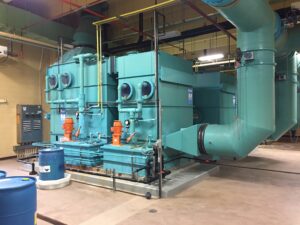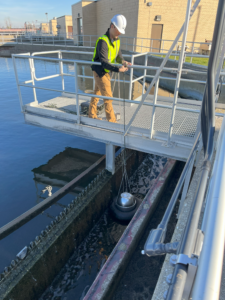How to Neutralize Ammonia Odor: A Step-by-Step Guide for Wastewater and Industrial Sites
 Ammonia odors are a common challenge in both wastewater treatment and industrial operations. These odors form when nitrogen-rich materials break down, releasing ammonia gas into the air. Facilities that manage sewage, food waste, or organic byproducts often deal with this issue every day.
Ammonia odors are a common challenge in both wastewater treatment and industrial operations. These odors form when nitrogen-rich materials break down, releasing ammonia gas into the air. Facilities that manage sewage, food waste, or organic byproducts often deal with this issue every day.
Leaving ammonia odors untreated can cause serious problems. Neighboring communities may file complaints. Health and safety risks can rise, especially for workers. Equipment may also suffer from corrosion when ammonia and other gases mix with moisture. Webster Environmental Associates (WEA) helps facilities manage these risks by providing targeted odor control plans built on real data.
Step 1: Identify Where Ammonia Odors Are Being Released
The first step in neutralizing ammonia odor is finding where it comes from. Common sources include pump stations, headworks at wastewater plants, aeration basins, and food processing waste areas. In industrial facilities, ammonia can also escape during chemical handling or material storage.
WEA starts with a thorough evaluation. Our team collects air and liquid samples throughout the site. We test for ammonia concentrations and other compounds like hydrogen sulfide. Air sampling and odor panel testing help confirm where the strongest emissions are happening. Without clear data, any odor control plan is just a guess.
Step 2: Choose the Right Neutralization Method
Once we know the sources, the next step is choosing the best method to treat them. One option is using acid-based chemical scrubbers. These systems spray an acidic solution, like sulfuric acid, into the air stream. The acid reacts with ammonia to form a harmless salt that can be removed from the system. Chemical scrubbers are a strong choice for sites with high ammonia concentrations.
In other cases, biofilters or biotrickling scrubbers may work better. These systems use microorganisms to break down ammonia naturally. They are often a good fit for sites with steady, moderate emissions. Biofilters require stable conditions like the right moisture level, pH, and temperature.
For more targeted needs, hydrogen peroxide can be used as an oxidizer. Hydrogen peroxide reacts quickly with ammonia in water streams, helping lower odor levels before the air is even released. WEA helps each client weigh these options based on site conditions and long-term goals.
Step 3: Consider Containment and Airflow Management
Treating the air is only part of the solution. Controlling how air moves through a facility is just as important. Many ammonia odor problems get worse when gases leak from uncovered tanks, poorly sealed ductwork, or open work areas.
WEA often recommends adding enclosures over tanks or process areas. Proper ventilation systems are installed to collect odorous air and send it to treatment units. Sometimes, upgrading or redesigning ductwork can make a major difference.
We also use air modeling tools to study how odors move through and around a site. This helps predict where emissions might impact neighbors or workers. Planning containment and airflow based on real modeling data makes odor control much more reliable.
Step 4: Set Up Monitoring Systems for Long-Term Success
 After the main odor control systems are installed, monitoring becomes key. Ammonia concentrations can change over time due to flow changes, temperature shifts, or process updates. Facilities need a way to track those changes and adjust their systems.
After the main odor control systems are installed, monitoring becomes key. Ammonia concentrations can change over time due to flow changes, temperature shifts, or process updates. Facilities need a way to track those changes and adjust their systems.
WEA recommends installing real-time monitoring equipment. Ammonia and hydrogen sulfide monitors track gas levels and show trends over time. Data collected from these systems helps facilities adjust chemical feed rates, airflow settings, or maintenance schedules as needed.
Setting up good monitoring early saves money and prevents complaints later. It also gives facilities clear proof that they are meeting regulatory limits.
How WEA Supports Each Step
At WEA, we help facilities with every part of the industrial odor control process. We start with air and liquid sampling to understand exactly what is happening. We use that data to design systems that fit the site’s specific needs. We recommend technologies like scrubbers, biofilters, hydrogen peroxide injection, or a mix of systems if needed.
Our team provides full support through installation and startup. We also offer staff training to make sure systems are operated safely and effectively. Long-term support is available too, including system audits, upgrades, and help with monitoring data.
Because WEA is independent from equipment manufacturers, our only goal is helping our clients pick the best tools for their needs—not selling specific products. That independence allows us to recommend creative combinations of technologies that many other firms do not.
Ready to Build an Ammonia Control Plan?
If your facility is dealing with ammonia odor challenges, Webster Environmental Associates is ready to help. We believe that odor control should be practical, data-driven, and built around the real conditions at your site.
Whether you need a simple upgrade or a full new system, we will walk you through the process from testing to installation. Contact WEA today to start planning a smarter, more reliable ammonia odor control system.
